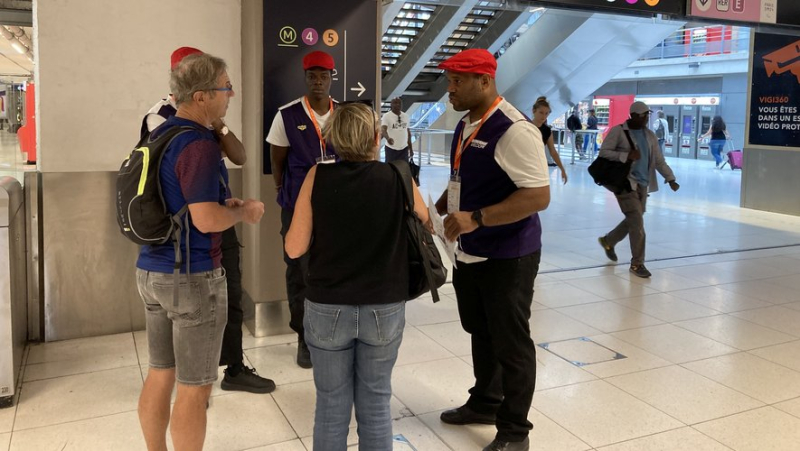Paris 2024 Olympics: lots of trains, well-managed flows… The divine surprise of Parisian transport that “rolls”

Des intérimaires en gilets violets, omniprésents pour renseigner les usagers et gérer les flux. Midi Libre – Richard Gougis
Far from the feared chaos, the RATP is there for the Olympics with additional trains and staff. The JO application also streamlines flows for the enjoyment of the public. A vital effort when the management accounted for more than 100 million euros; deficit in 2023.
We were told of a lack of trains and personnel, work not completed on time, a Parisian urban transport network on the verge of breakdown. In short, complete chaos. Four days after the opening ceremony, the transport sector, on the contrary, represents one of the divine surprises of these Olympic Games from the organizational side.
Also read:Paris 2024 Olympics: “It may be time to get your bike out”, the Ile-de-France region is preparing for an overload of its transport
“The lines have never been so fluid and faithful in terms of timetables… Those who fled the capital were perhaps wrong", laughs Yves, a retired Parisian who lives in the 18th. The arrival of the Tram has also contributed to transforming the north of Paris in a stunning way."
A thousand temporary workers
On the lines, both metro and RER, the traffic changes near Olympic sites such as the Concorde or the Grand Palais are rather well signposted and compensated by a tool that is rather unanimous.
Also read:Paris 2024 Olympics: the Games transport app, designed to facilitate spectator access to the Olympic sites, is now available
“The Paris-2024 transport app is fantastic, sums up Martine, who came from Alsace to experience the Games with her husband Dominique. The metro is cleaner than usual and there are almost too many staff to help us in the corridors!”
Informing and regulating flows near the Olympic sites competitions
Reference to these battalions of "purple vests", a thousand temporary workers, mostly students, hired for the Olympic and Paralympic period. Thierry, a computer science student, is one of them, present every evening on the platforms of line 5, Porte de Pantin. “We didn't have any specific training, he says, mostly day-to-day instructions based on needs.”
Mohamed is assigned to the platforms of the RER lines to regulate the flow when the trains arrive. “I speak English and Italian, that's the main skill sought, says this civil engineering student. People are generally quite understanding."
300 drivers hired
"They are first asked to be comfortable speaking, to smile and to be kind," explains Jérôme Heine, HR Director of RATP. The company also said it had recruited more than 5,300 staff this year, including 600 station agents and 300 drivers.
Back from the Stade de France, where they witnessed the exploits of their rugbywomen against the French, a group of Canadian supporters confirms the general satisfaction: “It's fluid, well organized even if it's sometimes a bit difficult with the language…”
15% more trains on average to meet demand
At midnight, at Châtelet-Les Halles, the crowds are still worthy of a 9am departure for the office. The wait, less than a quarter of an hour on average, is evidence of the number of additional trains put into circulation. +15% of metros and RERs compared to a typical summer with peaks of +70% on RER A and C and 25% on RER B, D and E.
An essential effort to meet the challenge of welcoming 7 million visitors during the Olympic Games without bottlenecks, with peaks of more than 500,000 spectators on certain days. The timely extension of line 14, a real expressway crossing Paris, was a strategic pillar of this network improvement plan.
109 million euros of losses in 2023
"We have done in 7 years what would have taken decades to implement", sums up Valérie Pécresse, President of the Île-de-France Region, to highlight the accelerating effect of the Olympic Games, as the network now allows people to travel from Orly to the centre of Paris in 25 minutes and the RER E has been extended to Nanterre. Its extension to Yvelines is expected by 2026 to further open up the capital and give credence to the hypothesis of a real Olympic turning point for transport.
Forget free transport…
This influx comes at just the right time for the RATP, which posted losses of 109 million in 2023 against a backdrop of soaring electricity prices and while the influx, weighed down by the Covid years, was still 14% lower than that of 2019.
Under these conditions, the only black spot remains the abandonment of the completely free transport, initially promised during these Games. The individual ticket at 4 euros still makes some teeth grind, but let's be honest: the Olympic Navigo package at 10 euros per day for unlimited travel is not likely to extinguish the flame that shines in the eyes of all visitors.
I subscribe to read the rest




